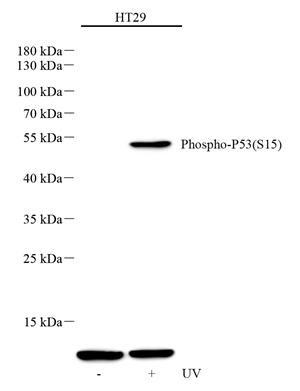Anti-Phospho-p53 (S15) Rabbit pAb (100 μl)
| Reactivity: | M,R |
| Applications: | IHC/IF |
| Host Species: | Rabbit |
| Clonality: | Polyclonal |
| Gene Name: | Cellular tumor antigen p53 |
Synonyms: | Antigen NY CO 13, Cellular tumor antigen p53, FLJ92943, LFS1, P53, Phospho-P53 (Ser15), Phosphoprotein p53, TP53, TRP53, tumor protein p53, Tumor suppressor p53, P-P53 |
Immunogen: | KLH conjugated Synthetic phosphopeptide corresponding to Human p53(S15) |
Uniprot ID: | P04637 |
Isotype: | IgG |
Purity: | Affinity purification |
Subcellular location: | Cytoplasm, Nucleus |
Predicted MW. / Observed MW. | 44/38/39/34/30/24 kDa / 53 kDa |
Product Usage Information
WB | Human | 1: 300-1: 600 | HT29 |
Background
The p53 tumor suppressor protein plays a major role in cellular response to DNA damage and other genomic aberrations. Activation of p53 can lead to either cell cycle arrest and DNA repair or apoptosis . DNA damage induces phosphorylation of p53 at Ser15 and Ser20 and leads to a reduced interaction between p53 and its negative regulator, the oncoprotein MDM2. p53 can be phosphorylated by ATM, ATR, and DNA-PK at Ser15 and Ser37. Phosphorylation impairs the ability of MDM2 to bind p53, promoting both the accumulation and activation of p53 in response to DNA damage.
Images
| Western blot analysis of p-p53 (S15) (GB115050) at dilution of 1: 300 |
Storage
| Storage | Store at -20°C for one year. Avoid repeated freeze/thaw cycles. |
| Storage Buffer | PBS with 0.02%sodium azide,100 μg/ml BSA and 50% glycerol. |




